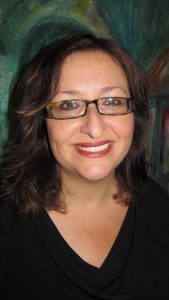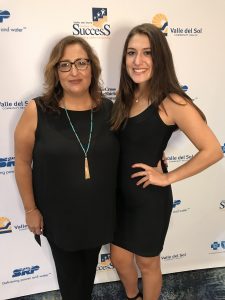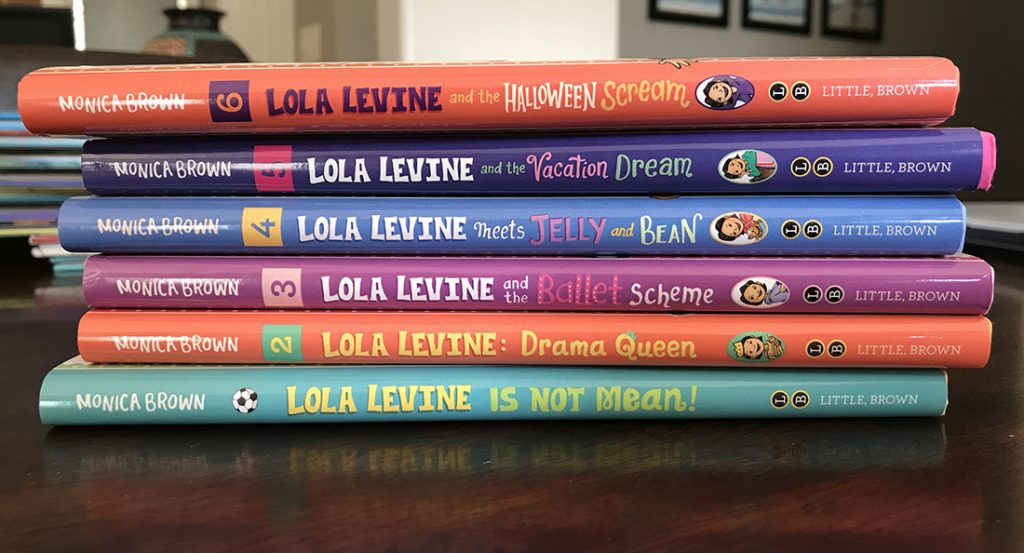By Heidi Toth
NAU Communications
Monica Brown remembers the day she was at a family wedding and an outside guest asked her why she and her cousin’s names didn’t match. The guest then speculated on her ethnicity and started referring to the “dark” cousins and the “light” cousins. Where did she fit in, the guest saw fit to wonder.
It stung.
But the children’s author and literature professor is nothing if not resourceful. She used that experience to create Marisol McDonald, the mixed-race heroine of “Marisol McDonald Doesn’t Match/Marisol McDonald no combina.”
“She’s a little girl who got teased for being different,” said Brown, a professor of English at Northern Arizona University. “She has olive skin and red hair and she is also nonconformist.”
Lola Levine, a fierce soccer-playing girl of Peruvian Catholic and Eastern Europe Jewish descent, was the next mixed-race character that followed Marisol out of Brown’s experiences and onto a page. Both characters became series, joining biographies of Pablo Neruda, Frida Kahlo and Pele on Brown’s expanding list of children’s picture books and chapter books. She writes these characters, both true and fictional, because she wants children of all races, ethnicities and backgrounds to find themselves and their heroes in the pages of her books.
Judging by their popularity, children have. So have their parents, and so have members of the Latino community in Arizona, who last week honored Brown and 11 others for their leadership.
Brown was recognized at an awards ceremony in Phoenix Friday at Valle del Sol’s Profiles of Success Hispanic Leadership Awards for not only her contribution to the arts but also her commitment to strengthening and standing up for the Latino community. It was a proud moment for the daughter of a Peruvian immigrant and mother of two multi-ethnic daughters.
“It’s important to hear these stories because here in Arizona, we often have negative rhetoric around immigration, borders and Latinos, and I reject that,” she said. “I hope the work I put out in the world challenges racism and fear. I want my work to share brilliant contributions of Latinos to this region that was once Mexico and is now, and always, Native American.”

The early years
At 18, Brown walked onto the campus of the University of California-Santa Barbara a declared English major. She’d always known she was going to be a writer. Her first job out of college was as a newspaper reporter in Guadalajara, Mexico.
But she realized something in Guadalajara: she wasn’t cut out to be a journalist. The writing about violence, local business and disasters wasn’t right for her. She loved writing about culture and the arts. While considering her next steps, Brown remembered a conversation she’d had at UCSB. During her senior year, professor Carl Gutierrez-Jones invited her into his office after a senior seminar and asked if she’d thought about grad school.
She hadn’t.
“He said, ‘you can write,’” Brown remembered. “So I had that idea in my head, and it was thanks to this Chicano professor that I applied to graduate school. He told me I had a voice and something to say.”
She returned to the United States, earning a master’s degree from Boston College and a doctorate from Ohio State University and authoring her first book, “Gang Nation: Delinquent Citizens in Puerto Rican, Chicano, and Chicana Narratives.” It was during a Rockefeller Fellowship on Chicano/a Cultural Literacies she began writing children’s books. Her two daughters were young, and she found a void where characters of Latino, multicultural and mixed-race families would be.
“We have new generations of writers that are changing that, but still, our children’s literature doesn’t really reflect our social make-up,” Brown said. “For me, writing about multiracial and multicultural experiences was especially important. That’s the fastest-growing demographic group in the U.S.”
She wrote biographies of Latino figures she loved and wanted to share—Dolores Huerta, Gabriel Garcia Marquez, Pablo Picasso and Celia Cruz. Bringing Marquez to life for children inspired her to create her own story of magical realism in “Chavela and the Magic Bubble,” the story of a girl who takes a chicle ride to a magical rainforest.
She drew on her daughters to create Lola Levine, a fierce, competitive, soccer-playing girl, and Lola’s eventual best friend, Bella, a graceful ballerina. The two girls don’t like each other at first, but soon they discover how much they have in common.

There is a theme running through Brown’s books: strong, smart girls who are fun and competitive and want to be who they are. And her audience has taken to that. Children of all races relate to Marisol because a lot of them don’t feel like they fit into one place, she said.
“I’ve had so many little kids come up to me with their parents, and they’re not always Latino, and they say, ‘I’m Marisol McDonald!’” she said. “Maybe they like to be mismatched dressing or they’re nonconforming or they really embrace the idea of being yourself. I write for all children, and of course I want all my work to be a gift, especially to those who haven’t seen themselves in children’s books.”
Marisol, who now is in a three-part series, also recently was optioned by Amazon Digital, Brown said. It’s still early in the process, but a potential series and pilot episode are in development. She’s hopeful her little mismatched heroine will soon get to speak to more children.
“I always say, and others have too, diversity isn’t a trend, it’s a demographic fact,” she said. “For all writers, the basis has to 
Spreading the word
Brown has spent about as many years on book tours and going to book festivals as she has writing books, so she’s had many opportunities to be an ambassador for her characters and her beliefs. She celebrates that her characters are bilingual. She highlights obstacles they’ve overcome, telling readers that Pele, the greatest soccer player in the world, started on the “barefoot team” and used grapefruits or newspapers stuffed in socks instead of a ball because he was so poor.
She has gone to U.S. embassies in Chile, Panama and Peru as a visiting specialist and represented the United States, Arizona and NAU at national and international book festivals. While in Chile she did an interview for a radio show at the Chilean embassy (in Spanish, which is her second language). It was awkward, she said with a laugh, admitting she never listened to it. But she’s proud of her multiracial, bilingual heritage.
These days most of Brown’s writing is in her books, but she’s also writing op-eds or speaking out about the ways people see her community.
“I believe we all have responsibilities as global citizens, and if I can contribute to the Latino community and all of Arizona, I want to, and the best way I can is through connecting with children and also speaking about education, literacy, bilingualism and social justice in school curriculum,” she said.
Brown also gets to share her love of Chicano literature closer to home, teaching U.S.-Latino and African-American literature in her classes. In May, she was the keynote speaker at NAU’s Hispanic convocation, giving her speech both in English and Spanish. She said as she looked at that room of bright, accomplished students, she was filled with pride.
“That’s how I know we’re doing good things at NAU—as teachers, as writers, as artists—because they’re graduating and every student that I saw graduate at the Hispanic convocation is going to make a positive impact,” Brown said. “The students that graduate from NAU are part of the future of our state, and as teachers, we are lucky to be part of their journey.”
The award
Brown’s books have attracted significant attention through the years, with various books having won the Américas Award for Children’s Literature, Orbis Pictus Honor for Outstanding Nonfiction, a Christopher Award, the Tejas Star Book Award and the International Latino Book Award. “ Lola Levine, Drama Queen” is currently a Texas Bluebonnet Finalist.

But this award is special.
“It means so much coming from the Latino community here,” she said.
Brown won the Latino Excellence in Arts, Culture and Literature Award. She was on the stage with Dr. Javier Cárdenas, a neurosurgeon studying concussions, Raúl Grijalva, the longtime representative for Arizona’s 3rd Congressional District, state Sen. Catherine Miranda and Ernie Lara, president of Estrella Mountain Community College, a majority-minority institution.
“The people I was on stage with are my superstars and inspirations and heroes, so it’s a huge honor to be among people like Dr. Javier Cárdenas,” she said. “That I even got to meet him is incredible.”
Funnily, Brown was nominated by someone who heard her speak. She didn’t recognize the nominator’s name or know what speech inspired the mystery nominator. That was one of the most persuasive factors in Brown’s selection, said Angela Florez, chief development officer for Valle del Sol.
“What we’re looking for is somebody who has spent their entire career in service specifically to the Latino community. Monica’s art does just that,” Florez said. “It helps start kids on a path of understanding all of the nuances and the beauty that exist within the Latino community.”
In the news
Hear Monica on All Things Considered and NBC Latino.
Read about Monica’s works on NBC News, The New York Times and publisher Little, Brown’s author essay.



